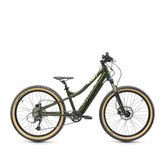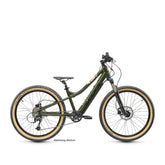Five tips for a safe way to school by bike
Going to school by bike? Sure, of course!
We have five tips to help your child get there and back safely.
1. Practice traffic rules
Before you let your child ride their bike alone on the road, they should be familiar with the usual traffic rules and have regularly practiced the correct behavior in traffic. Train with your child as often as possible and make them aware of the need to behave attentively and carefully with regard to other road users.
Traffic training areas are a wonderful opportunity to practice traffic rules in a safe environment.
Participating in a bicycle test can also be a guide for parents as to whether their child knows how to behave safely in traffic. Furthermore: be a role model! Children imitate the behavior of adults, preferably their own parents.
2. Plan and leave the route to school
Plan your way to school taking the current traffic situation into account: Do you have to pass intersections or confusing streets, are there traffic lights or zebra crossings, is there a higher volume of traffic in certain places? Remember: the shortest route to school does not necessarily mean the safest. Plan the route to school so that your child can manage it as easily as possible.
Already knew? Children must ride on the sidewalk until they are eight years old and are even allowed to ride on the sidewalk until they are ten.
Go through the route to school carefully and drive it several times with your child before the first solo tour. Please take your school bag with you so that your child can get a feel for it.
3. Safe and visible protective clothing
Nothing works without a helmet! Regardless of whether the school is right around the corner, a bicycle helmet is mandatory. Make it clear to your child that head protection is essential on the bike. Another important factor for your child's safety on the road is their visibility to other road users.
In fact, tricky situations in road traffic usually arise when you are noticed too late or not at all by other road users.
Helmets in bright signal colors with integrated lighting, colorful, reflective clothing, reflective material on backpacks and school bags or high-visibility vests ensure better visibility for your child even in poor visibility conditions.
4. Ensure a roadworthy bicycle
According to the Road Traffic Licensing Regulations (StVZO), a children's bike is already equipped with rear and front lights, cat eyes, reflectors, brakes and a bell. In addition, additional lights and reflectors can be attached to increase visibility.
Since children are easily obscured by parked cars due to their size, they are often not seen crossing the street until they are already on the street. Such dangerous situations can be avoided using pennants mounted on the bicycle, which visually enlarge the bicycle.
5. Plan enough time
Rushing impairs attention!
Anyone who has to hurry to get to school on time runs the risk of being careless. So make sure to send your child off on time so that they don't come under time pressure.
Our conclusion
Cycling the daily way to school offers your child additional exercise, is quick and protects the environment.
In order for your child to get there and back safely, they should be familiar with the traffic rules and be familiar with how to behave in traffic. Previous visits to traffic training areas or taking a bicycle test can be helpful.
Bright and reflective clothing further increases safety. The better your child can be seen by other road users, the more safely he or she can move around in traffic.
Make sure that your child's bike is up to date with the latest road traffic regulations and regularly practice the correct behavior in traffic with him.
With this preparation, nothing stands in the way of your daily journey to school.




